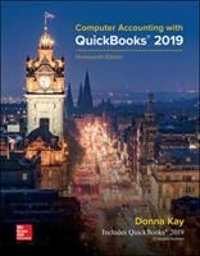Question
Guess Klein produces designer clothing such as T- shirts and jeans from fabric purchased from several nearby factories. The company's factory has two departments, Cutting
Guess Klein produces designer clothing such as T-
shirts and jeans from fabric purchased from several nearby factories. The
company's factory has two departments, Cutting and Sewing. The Cutting
department, which cuts the garments from patterns, is a machine-intensive
operation. It takes three times longer to cut and sew jeans compared to T-
shirts. The Sewing department stitches the cut fabric, sews zippers and
buttons and does quality checking. While stitching is highly automated,
sewing zippers and buttons and performing quality checks is manual.
Direct materials are traced to individual products but direct labor is treated
as a single cost pool and averaged across all garments produced. Nearly 80%
of the labor hours in the Sewing department are for manual sewing of
zippers and buttons on jeans. T-shirts typically do not have zippers or
buttons.
The company uses a traditional department based overhead allocation
system. It assigns overhead to departments and charges them to products
using departmental rates. Cutting Department overhead is allocated using
machine hours and Sewing Department overhead is allocated using number
of garments produced. The indirect costs and the bases used for allocating
them to the departments are shown in the Table below. During the current
period, 50,000 jeans and 100,000 T-shirts were produced. A typical shipment
consists of 1,000 jeans and 2,000 T-shirts.
Table 1
Budgeted Cost Data for Guess Klein Garments
Directly Traced Costs:
Cutting
Sewing
Total
Direct Materials
160,000
40,000
200,000
Direct Labor
120,000
75,000
195,000
Indirect Labor
10,000
10,000
20,000
Equipment depreciated & supplies
20,000
60,000
80,000
Indirect Costs allocated:
Repairs & maintenance (Machine hours)
?
?
200,000
Employee support costs (Labor hours)
?
?
120,000
Occupancy costs (Square feet)
?
?
70,000
TOTAL COST
885,000
Overhead Bases:
Machine Hours
3,000
1,000
4,000
Labor Hours
2,000
4,000
6,000
Square Feet
3,000
2,000
5,000
Table 2
Budgeted Product Data for Guess Klein Garments
Product
Jeans
T-shirts
Total
Direct Materials
125,000
75,000
200,000
Direct Labor (Allocated on garments produced)
65,000
130,000
195,000
Machine Hours
3,000
1,000
4,000
Garments produced
50,000
100,000
150,000
Assume that the total Sewing Department budgeted overhead cost (both
direct and indirect) is $240,000. Assume also that 160,000 garments were
actually produced during the year and that actual Sewing Department
overhead was $249,000. During the year, overhead was:
Over applied by
$9,000
Over applied by
$7,000
Over applied by
$16,000
Under applied by
$7,000
QUESTION7
(Not a repeat question.) Robotics Inc. assembles solar cells in a highly
automated environment with a JIT inventory system. The manufacturing
plant occupies 50% of the total buildings and grounds. Robotics has a small
highly skilled and Fexible labor force that has a lifetime employment
guarantees. actory supplies are used in the production of solar cells. About
25% of the plant's utility costs represent connection charges; the rest vary
with production. External vendors provide all of the materials and supplies.
Sales force is paid entirely on commissions. Advertising spending is set by
contract at the beginning of the year. At full capacity, the plant is capable of
producing 100,000 units per year. Last year Robotics manufactured and sold
94,000 units for the costs listed below.
Cost Item
Amount
Direct Materials & Parts
$300,000
Direct Labor
350,000
Production Supervisory Salaries
100,000
actory Supplies
200,000
Plant Utilities
60,000
Sales Commissions
350,000
Building/Grounds Maintenance
40,000
Advertising
100,000
Administrative Salaries
400,000
Total
$190,000
The total variable costs last year were:
$690,0
00
$910,0
00
$895,0
00
$850,0
00
QUESTION8
(Not a repeat question.) Robotics Inc. assembles solar cells in a highly
automated environment with a JIT inventory system. The manufacturing
plant occupies 50% of the total buildings and grounds. Robotics has a small
highly skilled and Fexible labor force that has a lifetime employment
guarantees. actory supplies are used in the production of solar cells. About
25% of the plant's utility costs represent connection charges; the rest vary
with production. External vendors provide all of the materials and supplies.
Sales force is paid entirely on commissions. Advertising spending is set by
contract at the beginning of the year. At full capacity, the plant is capable of
producing 100,000 units per year. Last year Robotics manufactured and sold
94,000 units for the costs listed below.
Cost Item
Amount
Direct Materials & Parts
$300,000
Direct Labor
350,000
Production Supervisory Salaries
100,000
actory Supplies
200,000
Plant Utilities
60,000
Sales Commissions
350,000
Building/Grounds Maintenance
40,000
Advertising
100,000
Administrative Salaries
400,000
Total
$190,000
Assume that the full cost per unit was as follows:
Variable costs
$10.00
ixed costs
11.00
Total cost per unit
$21.00
What is the average full cost per unit if next year the production falls to
86,000 units and there is no change in the unit prices of all cost inputs used
by Robotics?
$22.
02
$21.
00
$20.
21
$22.
95
Step by Step Solution
There are 3 Steps involved in it
Step: 1

Get Instant Access to Expert-Tailored Solutions
See step-by-step solutions with expert insights and AI powered tools for academic success
Step: 2

Step: 3

Ace Your Homework with AI
Get the answers you need in no time with our AI-driven, step-by-step assistance
Get Started


